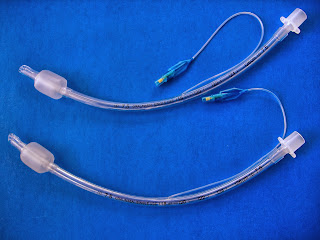วันอาทิตย์ที่ 29 กันยายน พ.ศ. 2556
Tracheal tube
In 1871 , Frederick Trendelendurg describes a tube that was inserted into the
Trachea through a tracheal cannula . The tube had a small , thick-walled , LowVolume inflatable rubber cuff.
In 1880 William McEwen describes , a Glasgow surgeon , the use of ETT past
blind to relieve into the trachea through the mouth and the airway obstruction
and anesthesia.
In 1893 , Eisenmenger in Vienna describes the first endotracheal tube with an inflatable
Cuff at high volume. The intra- cuff pressure may be estimated by scanning the
great driver tube.
In 1910 , Dorrance describes a tube similar to those inflatable cuff
today .
Described Guedel and Waters , 1928 A cuffed endotracheal tubes designed for closed
Circuits intratracheal administration of anesthesia using carbon dioxide
Absorption technique . This tube was similar to the tube Dorrance . He had a thin
Rubber sleeve is connected to the tube. When deflated rubber sleeve is in folds close
in the catheter wall . These tubes have been shown effective in the prevention of aspiration
and sealing the trachea.
In 1943 , Macintosh describes a tube with a self - inflating cuff Mushin created .
This ease cuff controlled ventilation for thoracic anesthesia. Holes were cut
in the tube under the cap , the cap and inflated only during inspiration. However,
Holes are sometimes blocked by mucus plugs.
Although the first endotracheal tubes tied was described in 1893, not handcuffs
Tubes were in common use until 1950. In 1952 , during the polio
Epidemic were used balloon catheter . After this experience, he has the standard
Clinical application of handcuffs tubes during anesthesia practice. The use of non - Cuff
Tubes is now a more common practice in pediatric anesthesia.
The first pipes were made of red rubber with rigid thick-walled cuffs. High collar and
Tracheal pressure were required to have an effective tracheal seal . this
Tubes were associated with major complications from the pressure
exerted on the wall of the trachea. These complications include erosion distal trachea.
A better understanding of the pathology associated cap led to an improved design
Wrists and techniques to limit the intra - cuff pressure . the introduction
Disposable plastic tubes was an important development that has largely moved
Rubber hoses .
The risk of cross contamination and toxins that are released by the red rubber tube ,
supports the tendency to use plastic pipes. In addition, rubber hoses
deteriorated autoclaved and were more resistant to breakage, pushing
the tube against the wall of the trachea.
สมัครสมาชิก:
ส่งความคิดเห็น (Atom)


ไม่มีความคิดเห็น:
แสดงความคิดเห็น